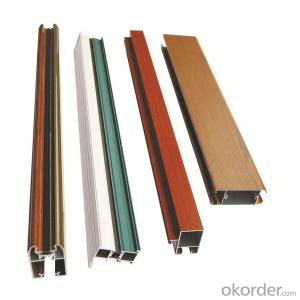Top quality aluminium profile
- Loading Port:
- China Main Port
- Payment Terms:
- TT OR LC
- Min Order Qty:
- -
- Supply Capability:
- -
OKorder Service Pledge
Quality Product, Order Online Tracking, Timely Delivery
OKorder Financial Service
Credit Rating, Credit Services, Credit Purchasing
You Might Also Like
Material | Alloy 6063,6061,6005or according to customer’s choice |
Temper | T3, T4, T5, T6 |
Surface | Anodize, electrophoresis, powder coating, PVDF coating, wood grain painting, matted, etc. |
Color | Any colour based on Standard Germany RAL Mark |
Length | Coating 6.5 meters, Anodizing 6.5 meters, Mill finish 5 meters |
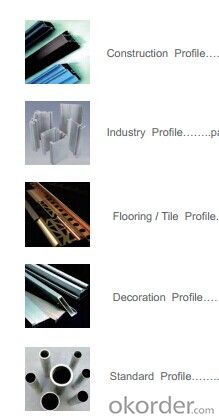

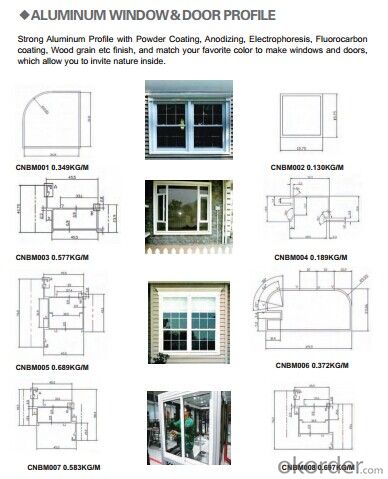
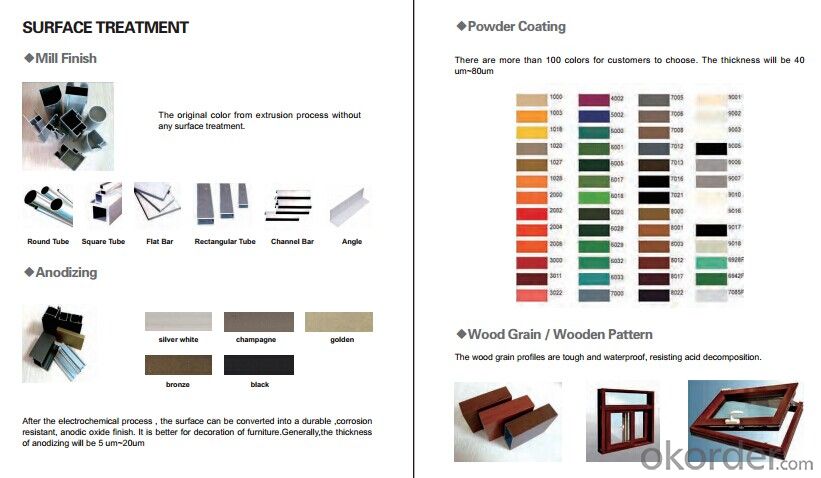
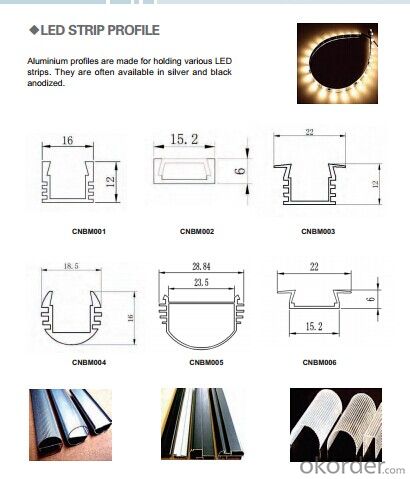
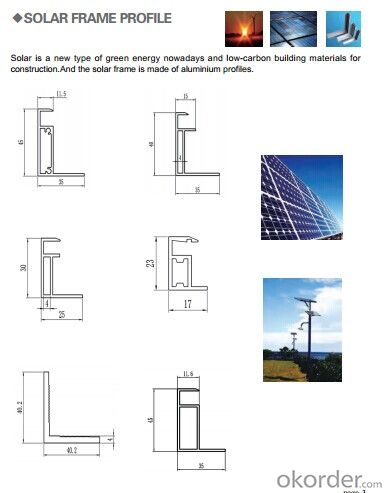
- Q:What are the standard dimensions of aluminum profiles?
- The standard dimensions of aluminum profiles can vary depending on the specific application and industry. However, some common standard dimensions include widths ranging from 10mm to 200mm and heights ranging from 10mm to 100mm. The length of aluminum profiles can also vary, with standard lengths typically ranging from 2 meters to 6 meters. It is important to note that these dimensions can be customized to meet specific project requirements.
- Q:Can aluminum profiles be customized according to specific requirements?
- Yes, aluminum profiles can be customized according to specific requirements.
- Q:Is aluminum alloy made of industrial aluminum?
- Aluminum profile is an applied product form of aluminum alloyAluminum is the aluminum bar through hot melt, extrusion, so as to obtain different cross-section of aluminum. The production process of aluminum profile mainly includes three processes: casting, extrusion and coloring.First, according to use can be divided into the following categories: 1. building doors and windows, aluminum doors and windows [1] (divided into two windows and curtain walls). Special aluminum radiator 2. CPU radiator 3. Aluminum Alloy shelf aluminum profile, the difference between them is that the different cross-sectional shapes. They are produced by hot melt extrusion 4.. Industrial aluminum: mainly used in automation equipment, sealing cover skeleton and the custom mold machinery and equipment according to their own requirements, such as assembly line conveyor belt, hoisting machine, glue machine, testing equipment, electronic machinery industry and clean room with the majority!
- Q:Can aluminum profiles be used in interior design applications?
- Certainly, aluminum profiles are a fantastic option for incorporating into interior design projects. Thanks to its versatility and durability, aluminum offers countless design possibilities. In fact, it can be utilized to fabricate a wide range of features, including doors, windows, partitions, furniture frames, lighting fixtures, and decorative accents within interior spaces. Aluminum profiles come in diverse shapes, sizes, and finishes, allowing for customization and adaptability in design. They can be anodized, powder-coated, or painted to match any desired color scheme. Moreover, aluminum profiles can be effortlessly shaped and manipulated to produce unique and intricate designs. One notable advantage of utilizing aluminum profiles in interior design is their lightweight composition, making them easy to install and handle. Additionally, aluminum is resistant to corrosion, enabling it to withstand moisture and humidity in areas such as bathrooms and kitchens. Furthermore, aluminum profiles offer long-lasting durability, as they resist warping, cracking, and fading. Consequently, they are an ideal choice for high-traffic areas or commercial spaces that require frequent use. Regarding aesthetics, aluminum profiles can provide a contemporary and streamlined appearance, elevating the overall design of a space. They can be paired with other materials like glass or wood to achieve a modern and sophisticated look. Furthermore, aluminum is an environmentally friendly and sustainable material. It can be fully recycled, thereby contributing to a reduced carbon footprint and a more sustainable approach to design. In conclusion, aluminum profiles are an excellent option for various interior design applications. Their versatility, durability, lightweight composition, and aesthetic appeal make them a popular choice for designers seeking functional and visually appealing solutions for interior spaces.
- Q:What are the impact resistance properties of aluminum profiles?
- Aluminum profiles have excellent impact resistance properties due to their inherent strength and durability. They can withstand high impact forces without deforming or breaking, making them suitable for various applications where impact resistance is crucial, such as automotive, construction, and aerospace industries. Additionally, aluminum profiles can absorb and distribute impact energy effectively, minimizing the risk of damage or injury.
- Q:Can aluminum profiles be used in the production of laboratory equipment?
- Laboratory equipment manufacturing can utilize aluminum profiles effectively. Aluminum, being a versatile material, finds application in multiple industries, including the production of laboratory equipment. Aluminum profiles provide numerous benefits in this regard. To begin with, aluminum possesses a combination of lightweight and strength, making it an ideal choice for constructing portable or frequently movable equipment within laboratories. Its lightweight nature reduces the strain on laboratory personnel while handling and transporting the equipment. Moreover, aluminum profiles offer easy shaping and molding capabilities, enabling the customization of laboratory equipment to meet specific requirements. This design flexibility allows for the creation of equipment with complex shapes and structures, ensuring optimal functionality and efficiency. In addition, aluminum exhibits excellent corrosion resistance, a crucial property in laboratory settings where exposure to chemicals and liquids is common. This corrosion resistance extends the lifespan of the equipment and maintains its good condition even after prolonged use. Furthermore, aluminum profiles can be anodized or coated to provide additional protection against wear, scratches, and other forms of damage. This enhances the durability and facilitates easier cleaning, ensuring the maintenance of required hygiene standards in laboratories. Lastly, aluminum possesses high conductivity, making it suitable for applications that require heat transfer or electrical conductivity. This property proves advantageous for laboratory equipment, such as heating plates, heat sinks, or electrical circuit components. In conclusion, aluminum profiles are indeed suitable for the production of laboratory equipment. Their lightweight, malleable, corrosion-resistant, and conductive properties make them an excellent choice for manufacturing various types of laboratory equipment, guaranteeing durability, functionality, and ease of use.
- Q:Can aluminum profiles be used in the construction of modular office spaces?
- Yes, aluminum profiles can definitely be used in the construction of modular office spaces. Aluminum profiles are lightweight, durable, and have excellent structural integrity, making them an ideal choice for modular construction projects. They can be easily fabricated and assembled to create various components such as walls, partitions, doors, windows, and framing systems for modular office spaces. Additionally, aluminum profiles offer great design flexibility, allowing for customization and adaptation to different office layouts and requirements. They are also highly resistant to corrosion, which is particularly beneficial in office environments where moisture and humidity can be present. Overall, aluminum profiles provide numerous advantages in terms of strength, versatility, and aesthetics, making them a popular choice for construction in modular office spaces.
- Q:Can aluminum profiles be used for medical equipment or devices?
- Yes, aluminum profiles can be used for medical equipment or devices. Aluminum is a lightweight and durable material that is commonly used in the manufacturing of various medical devices such as wheelchairs, surgical instruments, diagnostic equipment, and prosthetics. Its corrosion resistance, strength, and versatility make it suitable for a wide range of medical applications. Additionally, aluminum profiles can be easily customized and fabricated to meet specific design requirements, making them a popular choice in the medical industry.
- Q:How do aluminum profiles perform in earthquake-resistant structures?
- Aluminum profiles offer several advantages in earthquake-resistant structures. First and foremost, aluminum is a lightweight material, which means it has a high strength-to-weight ratio. This characteristic allows aluminum profiles to provide excellent structural integrity while minimizing the overall weight of the building. This is crucial in earthquake-prone areas as it helps reduce the forces exerted on the structure during seismic events. Additionally, aluminum is highly ductile, meaning it can deform significantly without losing its strength. This property allows aluminum profiles to absorb and dissipate seismic energy, thereby minimizing potential damage to the structure. The ductility of aluminum also ensures that it can withstand the lateral forces and vibrations generated during an earthquake, providing enhanced stability to the building. Moreover, aluminum profiles possess excellent corrosion resistance, which makes them ideal for earthquake-resistant structures in coastal regions or areas with high humidity. This corrosion resistance ensures the durability and longevity of the structure, even in harsh environmental conditions. Furthermore, aluminum profiles can be easily fabricated and assembled, offering versatility in design and construction. This flexibility allows architects and engineers to optimize the structural performance of the building, considering the specific seismic requirements of the region. In conclusion, aluminum profiles perform exceptionally well in earthquake-resistant structures due to their lightweight nature, high strength-to-weight ratio, ductility, corrosion resistance, and ease of fabrication. These characteristics make aluminum profiles a reliable choice for ensuring the safety and stability of buildings in seismic-prone areas.
1. Manufacturer Overview |
|
|---|---|
| Location | |
| Year Established | |
| Annual Output Value | |
| Main Markets | |
| Company Certifications | |
2. Manufacturer Certificates |
|
|---|---|
| a) Certification Name | |
| Range | |
| Reference | |
| Validity Period | |
3. Manufacturer Capability |
|
|---|---|
| a)Trade Capacity | |
| Nearest Port | |
| Export Percentage | |
| No.of Employees in Trade Department | |
| Language Spoken: | |
| b)Factory Information | |
| Factory Size: | |
| No. of Production Lines | |
| Contract Manufacturing | |
| Product Price Range | |
Send your message to us
Top quality aluminium profile
- Loading Port:
- China Main Port
- Payment Terms:
- TT OR LC
- Min Order Qty:
- -
- Supply Capability:
- -
OKorder Service Pledge
Quality Product, Order Online Tracking, Timely Delivery
OKorder Financial Service
Credit Rating, Credit Services, Credit Purchasing
Similar products
New products
Hot products
Related keywords
